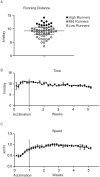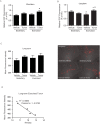Exercise modulates redox-sensitive small GTPase activity in the brain microvasculature in a model of brain metastasis formation
- PMID: 24804765
- PMCID: PMC4013134
- DOI: 10.1371/journal.pone.0097033
Exercise modulates redox-sensitive small GTPase activity in the brain microvasculature in a model of brain metastasis formation
Abstract
Tumor cell extravasation into the brain requires passage through the blood-brain barrier (BBB). There is evidence that exercise can alter the oxidation status of the brain microvasculature and protect against tumor cell invasion into the brain, although the mechanisms are not well understood. In the current study, we focused on the role of microenvironment generated by exercise and metastasizing tumor cells at the levels of brain microvessels, influencing oxidative stress-mediated responses and activation of redox-sensitive small GTPases. Mature male mice were exercised for four weeks using a running wheel with the average voluntary running distance 9.0 ± 0.3 km/day. Mice were then infused with 1.0 × 10(6) D122 (murine Lewis lung carcinoma) cells into the brain microvasculature, and euthanized either 48 hours (in short-term studies) or 2-3 weeks (in long-term studies) post tumor cell administration. A significant increase in the level of reactive oxygen species was observed following 48 hours or 3 weeks of tumor cells growth, which was accompanied by a reduction in MnSOD expression in the exercised mice. Activation of the small GTPase Rho was negatively correlated with running distance in the tumor cell infused mice. Together, these data suggest that exercise may play a significant role during aggressive metastatic invasion, especially at higher intensities in pre-trained individuals.
Conflict of interest statement
Figures




References
-
- Hoyle M, Crathorne L, Peters J, Jones-Hughes T, Cooper C, et al. (2013) The clinical effectiveness and cost-effectiveness of cetuximab (mono- or combination chemotherapy), bevacizumab (combination with non-oxaliplatin chemotherapy) and panitumumab (monotherapy) for the treatment of metastatic colorectal cancer after first-line chemotherapy (review of technology appraisal No. 150 and part review of technology appraisal No. 118): a systematic review and economic model. Health Technol Assess 17: 1–237. - PMC - PubMed
-
- Mena AC, Pulido EG, Guillen-Ponce C (2010) Understanding the molecular-based mechanism of action of the tyrosine kinase inhibitor: sunitinib. Anticancer Drugs 21 Suppl 1 S3–11. - PubMed
-
- Aragon-Ching JB, Zujewski JA (2007) CNS metastasis: an old problem in a new guise. Clin Cancer Res 13: 1644–1647. - PubMed
-
- Disibio G, French SW (2008) Metastatic patterns of cancers: results from a large autopsy study. Arch Pathol Lab Med 132: 931–939. - PubMed
Publication types
MeSH terms
Substances
Grants and funding
LinkOut - more resources
Full Text Sources
Other Literature Sources
Medical

